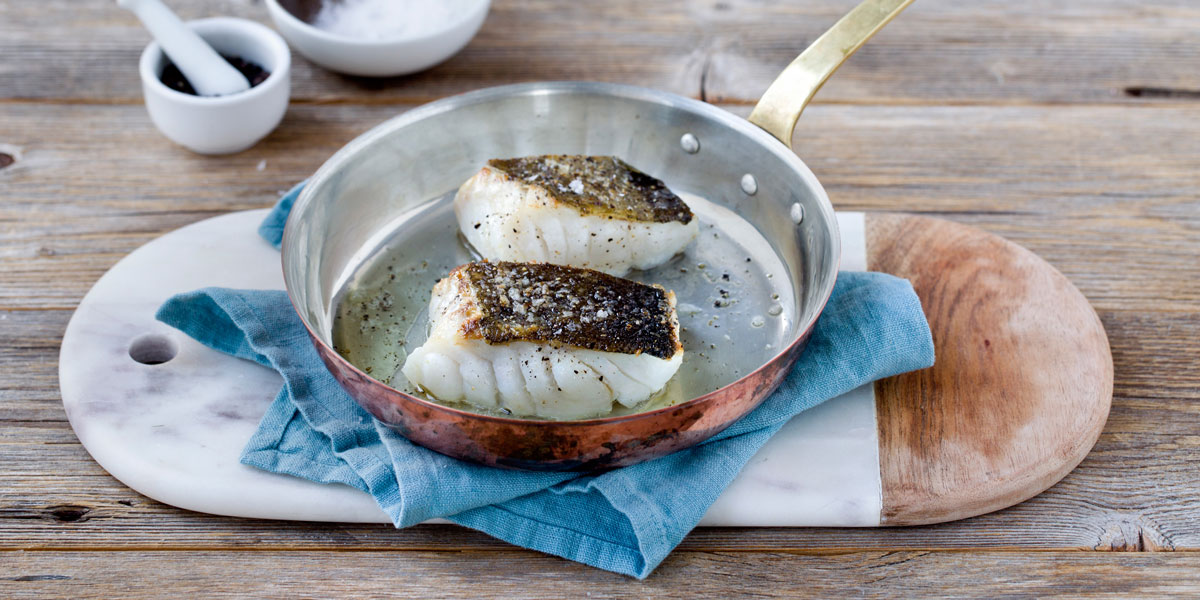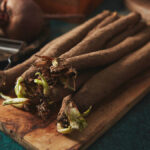Norwegian Skrei Cod

Caught straight from the cold, clear waters of Northern Norway, Skrei (pronounced Skray) is a migratory cod from Norway, caught in its prime and in perfect condition after an arduous 1,000km swim from the Barents Sea to Northern Norway, and it is only available from January-April every year.
Skrei fishing in Norway has an extraordinary history with at least 1,000 years of recorded seafaring and fishing heritage dating all the way back to the age of the Vikings, that have helped shape Norway into the country it is today. Today this annual phenomenon is met with great celebration each year, as hundreds of millions of Norwegian cod migrate back to their spawning grounds yet only a small percentage of all landed cod will be branded with the prized dorsal fin Skrei branding, which acts as a quality assurance.
Thanks to its rather epic migration, Skrei is lean and rich in protein, vitamins and minerals. It also enjoys a firm flesh with obvious fat lines and chunky pearly white flakes that melt away effortlessly during cooking. The fish can be prepared in a variety of ways and can be enjoyed both raw and cooked.
Since its introduction to the UK in 2012, Skrei has been swept up by our finest chefs, including Ambassador Michel Roux Jr, Simon Hulstone and Daniel Galmiche who have all served Skrei in season at their Michelin-starred restaurants. Even Monica Galetti, Ollie Dabbous and Robin Gill have ventured out of their kitchens to Norway to catch and eat Skrei right at its source.
Michelin-star chef Michel Roux Jr comments:
As a chef, I am always looking for exceptional ingredients, Skrei cod is one of those that never lets me down. The texture, taste and assured quality is what makes Skrei one of the finest products to cook with.
Due to the nature of the migratory cod, the arrival date of Skrei to the UK market is often tricky to predict and it is stocked by a small number of suppliers including Booths, as well as being served in selected Michelin star and fine dining restaurants.
Serving Suggestions:
Delicious as a ceviche; firm textured and sweet, or try just lightly curing it and serving thinly sliced with olive oil, lemon, dill and sea salt as a mouth-watering starter.
For a main course, why not try brining some of the loin, then roasting and serving with a little braised fennel and anchovy. With such a delicate, yet full flavour to the meat, the fish can be served simply, with nothing more. After just a short time in the oven, the muscle and fat between the flakes will melt away and you can just push each one off with your fork.
For a more traditional approach, serve Skrei simply with boiled potatoes and steamed carrots – letting all the flavours of the fish do the talking. And if you are feeling adventurous, the classic way to prepare Norwegian Skrei is called “Mølje,” which is a simple, popular dish. To prepare this dish, in separate pots, poach the fish, liver and roe in lightly salted water; then serve with boiled potatoes. Skrei tongue and roe are considered by many to be a prized delicacy.
Top Skrei Cooking Tips From Ambassador Michel Roux Jr
To Pan fry Skrei: Make sure the Skrei is dry and the pan very hot. Add a little vegetable oil to the pan and carefully place the seasoned fish in the pan. Once lightly seared, then add lots of butter and baste with frothy bubbling butter. To test if cooked use a skewer, it should go through the fish easily
To Poach Skrei: To poach Skrei perfectly, rule nº1 is to quickly bring the poaching liquid to the boil then turn down the heat to a very gentle simmer for the rest of the cooking duration, otherwise the fish will be tough and dry
Quality-Labelled Skrei
Skrei is such a revered product in Norway that it has its own grading standard. Hundreds of millions of Norwegian cod migrate each year back to their spawning grounds of Lofoten and Vesterålen, yet only a small percentage of all landed cod will be branded with the prized dorsal fin Skrei tag, which acts almost like a seal of approval or quality assurance. It is only the very best of this migratory cod qualifies for the Skrei branding, having to meet stringent quality standards.
- Caught fully grown – as a large mature cod before it has spawned (approx. five years old)
- In pristine condition, with no scratches, bruising or injuries – the fish must look as good as it tastes
- Packed by trained staff within 12 hours of being caught
- Stored on ice at a temperature between 0° and 4° Celsius
- Third party quality controlled by the Fishery Sales Organisation
- Approved sustainable by Marine Stewardship Council
- Whole, fresh Skrei is required to have the Skrei brand fastened to the forward dorsal fin and put in a branded Skrei box




